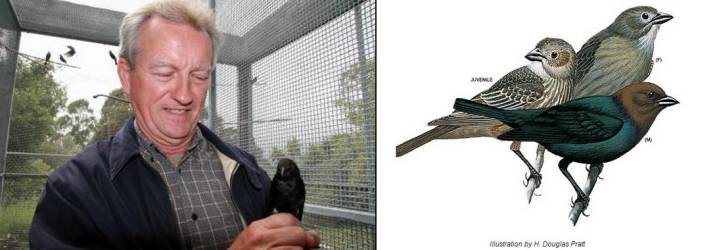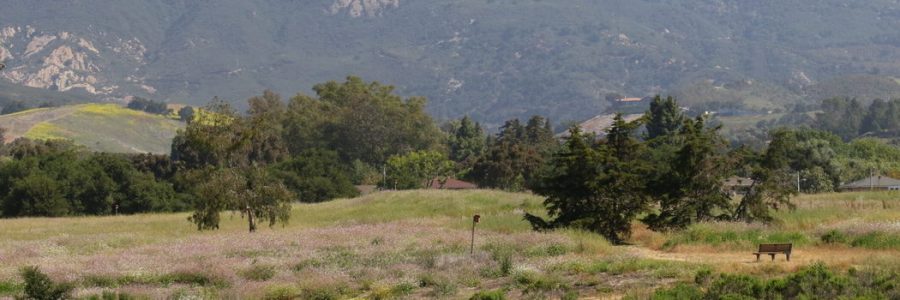
Wednesday, January 28, 2015, 7:30 pm - 9:00 pm
Join us this January as Dr. Adrian O’Loghlen from UCSB, speaks songbird communication and how this relates to his research on cowbirds. Doors open at 7:00 pm.
Cost: Free to the Public
Songbirds are one of the very few groups of animals known to learn their vocal behavior, i.e. their songs, and are used extensively as models for research into language acquisition and speech development in humans. There are many striking parallels between song development in songbirds and how infants and young children learn to speak a language. Language is a cultural tradition passed from generation to generation and some species of songbirds also have cultural traditions called ‘song dialects’ which are equivalent in some ways to the regional dialects or accents in languages. Song dialects are distinct variations of the song(s) that a species typically sings and each discrete dialect is found only in a specific, often local, population. The dialects of White-crowned Sparrow are one of the most studied of these avian vocal traditions but perhaps the most distinctive are the dialects of brown-headed cowbird populations in the Sierra Nevada. Dr. O’Loghlen will describe these remarkable dialect populations and talk about the research that he and Dr. Steve Rothstein (UCSB) have conducted on these populations over the 40 years or so that they have been studied. A key question in studies of dialects, both in humans and in songbirds, concerns the factors that prevent dialects from changing or breaking down overtime and he will describe their research into the social and environmental factors that appear responsible for the stability of cowbird dialects. Interestingly, despite their parasitic ‘lifestyle’ which involves the exploitation of parental care provided by ‘host’ species, cowbirds are extremely social and are one of the leading model species used in studies of social influences on vocal learning. Dr. O’Loghlen will include demonstrations of the extraordinary songs and singing behavior of cowbirds, the complexity of which has led to cowbirds being described as “the undisputed winner in the decathlon of avian vocalizations” and will present their most recent research on the bowing displays that male cowbirds perform when they sing their “gurgling water” songs to other cowbirds.
Dr. O’Loghlen graduated from University College Dublin (Ireland) with a BSc. in Chemistry in 1970 and worked in advertising in London (UK) until 1987 when he moved to Santa Barbara and enrolled at UCSB as a biology student. He was awarded a PhD in Behavioral Ecology in 1993 and moved to Seattle to take a position as a Postdoctoral Fellow at the Dept. of Psychology at University of Washington (UW) working on the vocal behavior in song sparrows. Since then he has worked as a Lecturer at UW (Fall/Winters) and Research Scientist/Co-Principal Investigator at UCSB (Spring/Summers). In 2011, he moved to Goleta and continues to work as a Research Scientist and Lecturer in Vertebrate Zoology at UCSB. In addition, every summer he returns to Seattle to teach a course at UW on how studies of animal behavior can provide us with insights into human behavior. His research has focused on social and environmental factors that influence which songs a young male songbird learns to sing and how male singing behavior can be influenced by female sexual preferences for certain types of song. The subject of his research is the much maligned Brown-headed Cowbird, which despite its notorious reputation is one of the leading species for research on social influences on vocal learning. His studies of cowbird song dialect populations in the Sierra Nevada of California which were conducted in collaboration with his former graduate advisor, Dr. Steve Rothstein (UCSB), have demonstrated that the development of singing behavior in male songbirds can be more complex and prolonged in wild populations than had been previously thought based mainly on research using captive birds. More recently their research has turned to investigating audiovisual communication in songbirds using the bowing wing-spread displays male cowbirds perform when they sing to other cowbirds. In 2010, they achieved a significant breakthrough in this area when they developed procedures to induced female cowbirds to perform sexual displays in response to video recordings of males singing. This is the first time that this had been achieved in a songbird and opens up a whole new area of potential research into audiovisual communication in songbirds.

